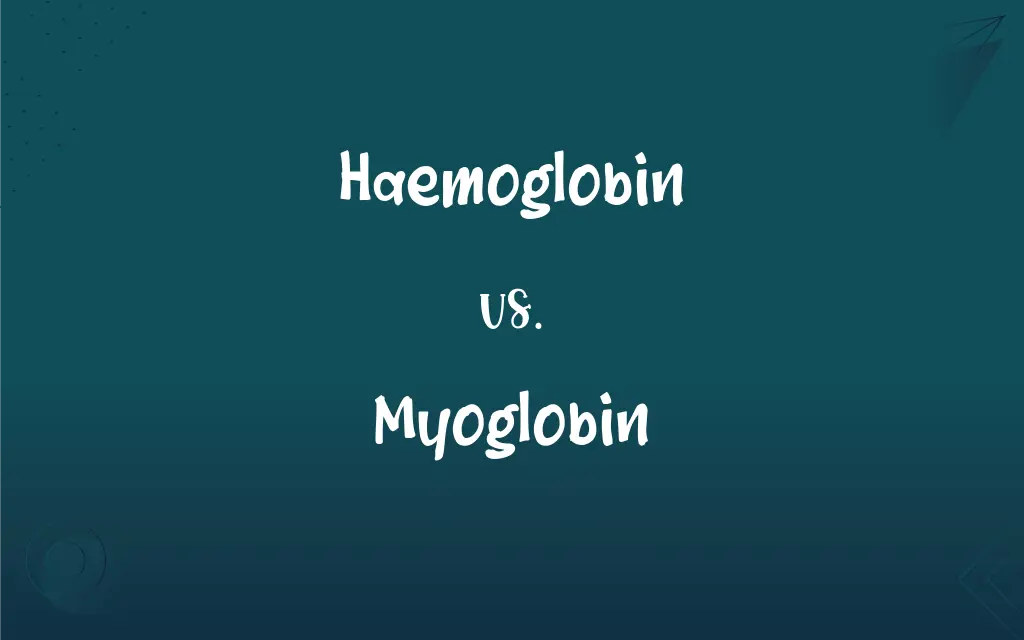Haemoglobin vs. Myoglobin: What's the Difference?
Edited by Janet White || By Harlon Moss || Updated on October 9, 2023
Haemoglobin is a red protein in blood that carries oxygen. Myoglobin is a protein in muscle that binds oxygen.

Key Differences
Haemoglobin is predominantly found in the red blood cells and is crucial for oxygen transport throughout the body. On the other hand, myoglobin resides in muscle cells and primarily facilitates oxygen storage and provides oxygen during muscular activity. Both are vital for maintaining oxygen levels in distinct areas within the organism.
The structural dissimilarity between haemoglobin and myoglobin is apparent in their polypeptide chain constitution. While haemoglobin consists of four polypeptide chains and exhibits cooperative binding to oxygen, myoglobin consists of a single polypeptide chain and does not exhibit cooperative binding.
Regarding oxygen affinity, haemoglobin demonstrates variable affinity due to its cooperative binding nature, ensuring efficient oxygen unloading in tissues and loading in the lungs. In contrast, myoglobin has a consistently high affinity for oxygen, ensuring it retains oxygen even under low oxygen concentrations, primarily serving as an oxygen reservoir during muscle activity.
The color distinction between oxygenated haemoglobin and myoglobin is notable: haemoglobin exudes a bright red hue when oxygenated, contributing to the characteristic color of arterial blood. Conversely, myoglobin, when oxygenated, presents a red-purple color, attributing a distinct tint to muscle tissue.
From a health perspective, alterations or anomalies in haemoglobin can lead to conditions like anemia, affecting the oxygen-carrying capacity of the blood. Abnormalities in myoglobin, especially its release into the bloodstream due to muscle damage, can be indicative of conditions like rhabdomyolysis, highlighting their respective significance in maintaining physiological and health aspects.
ADVERTISEMENT
Comparison Chart
Found in
Red blood cells
Muscle cells
Primary Function
Transports oxygen from lungs to cells
Stores and releases oxygen in muscles
Structure
Tetramer (4 polypeptide chains)
Monomer (1 polypeptide chain)
Affinity to Oxygen
Varies (cooperative binding)
High and constant
Color when Oxygenated
Bright red
Red-purple
ADVERTISEMENT
Haemoglobin and Myoglobin Definitions
Haemoglobin
A substance in red blood cells that helps to convey oxygen to body tissues.
A low haemoglobin level can be indicative of anemia, affecting energy levels and overall health.
Myoglobin
A hemoprotein in muscle tissue that is related to haemoglobin but differs in its physiological function.
Unlike haemoglobin, myoglobin has a higher affinity for oxygen, ensuring oxygen supply to working muscles even under conditions of low oxygen availability.
Haemoglobin
A bio-molecule that imparts the red color to the blood.
The deep red color of blood is due to its haemoglobin content, which varies among individuals.
Myoglobin
A vital protein in muscles that helps to maintain oxygen supply during anaerobic conditions.
During brief periods of anaerobic activity, myoglobin helps to maintain a supply of oxygen to ensure that muscles can continue to work effectively.
Haemoglobin
An iron-containing protein in red blood cells that reversibly binds oxygen.
Sickle cell disease is caused by a mutation in the haemoglobin gene, affecting its structure and function.
Myoglobin
A protein in muscle cells that binds to oxygen and helps transport it within the muscle.
Myoglobin releases its bound oxygen during periods of low oxygen availability, such as during strenuous exercise.
Haemoglobin
A red protein responsible for transporting oxygen in the blood of vertebrates.
Haemoglobin binds with oxygen in the lungs and releases it in tissues to facilitate cellular respiration.
Myoglobin
An oxygen-storing protein in muscle cells that facilitates oxygen use during muscle contraction.
Diving mammals, such as whales, have high concentrations of myoglobin in their muscles, allowing them to remain submerged for extended periods.
Haemoglobin
A critical component in blood that participates in oxygen and carbon dioxide exchange in the body.
During intense exercise, haemoglobin delivers the necessary oxygen to muscle cells throughout the body.
Myoglobin
A red-pigmented protein that stores oxygen in muscle cells, releasing it during muscular activity.
The rich red color of some meats is due to the presence of myoglobin, which varies in concentration among different animals.
Haemoglobin
Alternative spelling of hemoglobin
Myoglobin
A single-chain, iron-containing protein found in muscle fibers, structurally similar to a single subunit of hemoglobin and having a higher affinity for oxygen than hemoglobin of the blood.
Haemoglobin
Same as Hemoglobin.
Myoglobin
(protein) A small globular protein, containing a heme group, that carries oxygen to muscles.
Haemoglobin
A hemoprotein composed of globin and heme that gives red blood cells their characteristic color; function primarily to transport oxygen from the lungs to the body tissues;
Fish have simpler hemoglobin than mammals
Myoglobin
A hemoprotein that receives oxygen from hemoglobin and stores it in the tissues until needed
FAQs
Where is myoglobin located?
Myoglobin is located in muscle cells.
What is myoglobin?
Myoglobin is a protein in muscle cells that stores and releases oxygen during muscle activity.
Why is myoglobin important?
Myoglobin is crucial for storing oxygen in muscles and providing it during physical activity.
What is haemoglobin?
Haemoglobin is a protein in red blood cells that transports oxygen throughout the body.
Where is haemoglobin found?
Haemoglobin is primarily found in the red blood cells.
Can haemoglobin carry other gases?
Yes, haemoglobin can also carry carbon dioxide and nitric oxide.
What causes low haemoglobin levels?
Anemia, vitamin deficiencies, and chronic diseases can cause low haemoglobin.
What is the structure of haemoglobin?
Haemoglobin is a tetramer, consisting of four polypeptide chains.
What is the structure of myoglobin?
Myoglobin is a monomer, consisting of one polypeptide chain.
How does myoglobin change color with oxygenation?
Oxygenated myoglobin is red-purple, and deoxygenated myoglobin is brown.
Is myoglobin found only in mammals?
No, myoglobin is found in the muscle tissue of various animals, including some birds and fish.
What diseases are associated with haemoglobin?
Diseases like anemia, thalassemia, and sickle cell anemia are associated with haemoglobin.
Why is myoglobin not found in blood tests like haemoglobin?
Myoglobin is primarily localized in muscle tissue, and significant amounts in the blood typically indicate muscle injury.
Can myoglobin carry other gases?
Myoglobin primarily binds with oxygen but can bind with carbon monoxide more tightly.
What does high myoglobin indicate?
High myoglobin levels often indicate muscle injury or damage.
Can haemoglobin levels be increased?
Yes, haemoglobin levels can often be increased with iron-rich diets or supplements.
Is haemoglobin found only in humans?
No, haemoglobin is found in nearly all vertebrates and some invertebrates.
Why is haemoglobin important?
Haemoglobin is vital for transporting oxygen from the lungs to the body’s tissues.
How does haemoglobin change color with oxygenation?
Oxygenated haemoglobin is bright red, while deoxygenated haemoglobin is dark red or purple.
Can you have too much myoglobin?
Yes, elevated myoglobin can indicate muscle damage and can be harmful if released into the bloodstream.
About Author
Written by
Harlon MossHarlon is a seasoned quality moderator and accomplished content writer for Difference Wiki. An alumnus of the prestigious University of California, he earned his degree in Computer Science. Leveraging his academic background, Harlon brings a meticulous and informed perspective to his work, ensuring content accuracy and excellence.
Edited by
Janet WhiteJanet White has been an esteemed writer and blogger for Difference Wiki. Holding a Master's degree in Science and Medical Journalism from the prestigious Boston University, she has consistently demonstrated her expertise and passion for her field. When she's not immersed in her work, Janet relishes her time exercising, delving into a good book, and cherishing moments with friends and family.































































